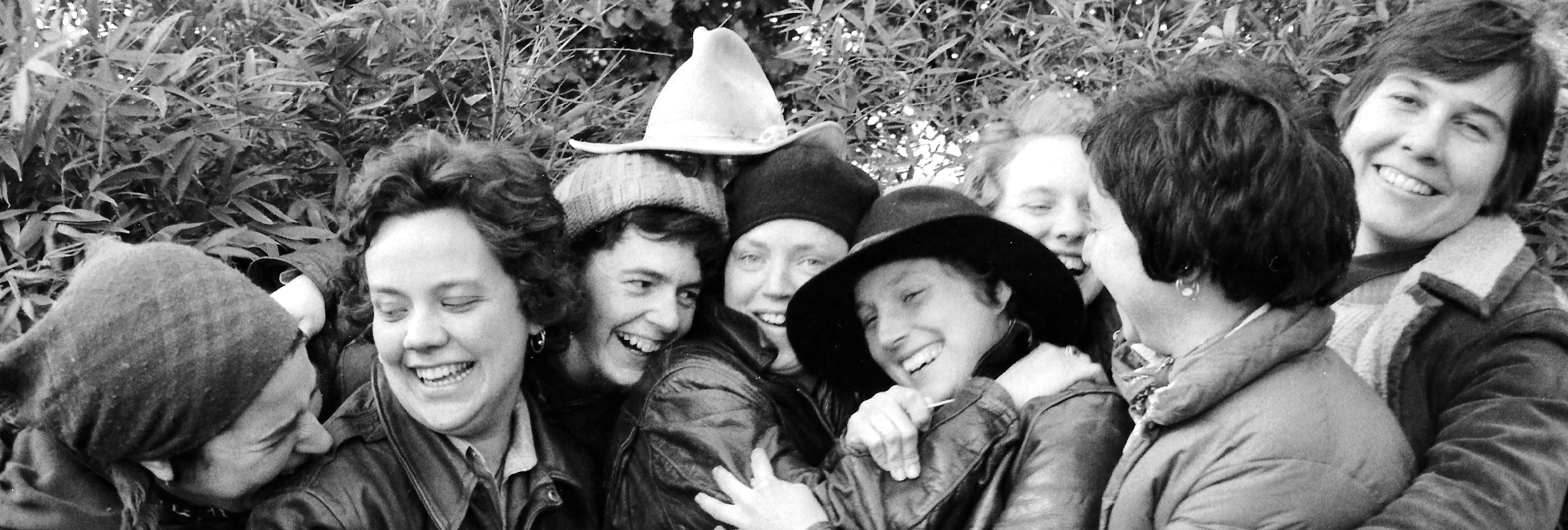
Meadow Muska: My Story
My Journey as a Lesbian Activist, Tradeswoman Advocate, and Social Documentary Photographer
| Childhood: "Only Boys Do Sports" | ||||||
| 1952 | ||||||
| Born and raised in, St. Paul, Minnesota. | ||||||
| 1967 - 1970 | ||||||
| I attended Ramsey High School in Roseville, Minnesota. Throughout high school, I sought refuge from an abusive family life by enrolling in Junior Achievement and in summer programs at the University of Minnesota, where I first took my first photography class. | 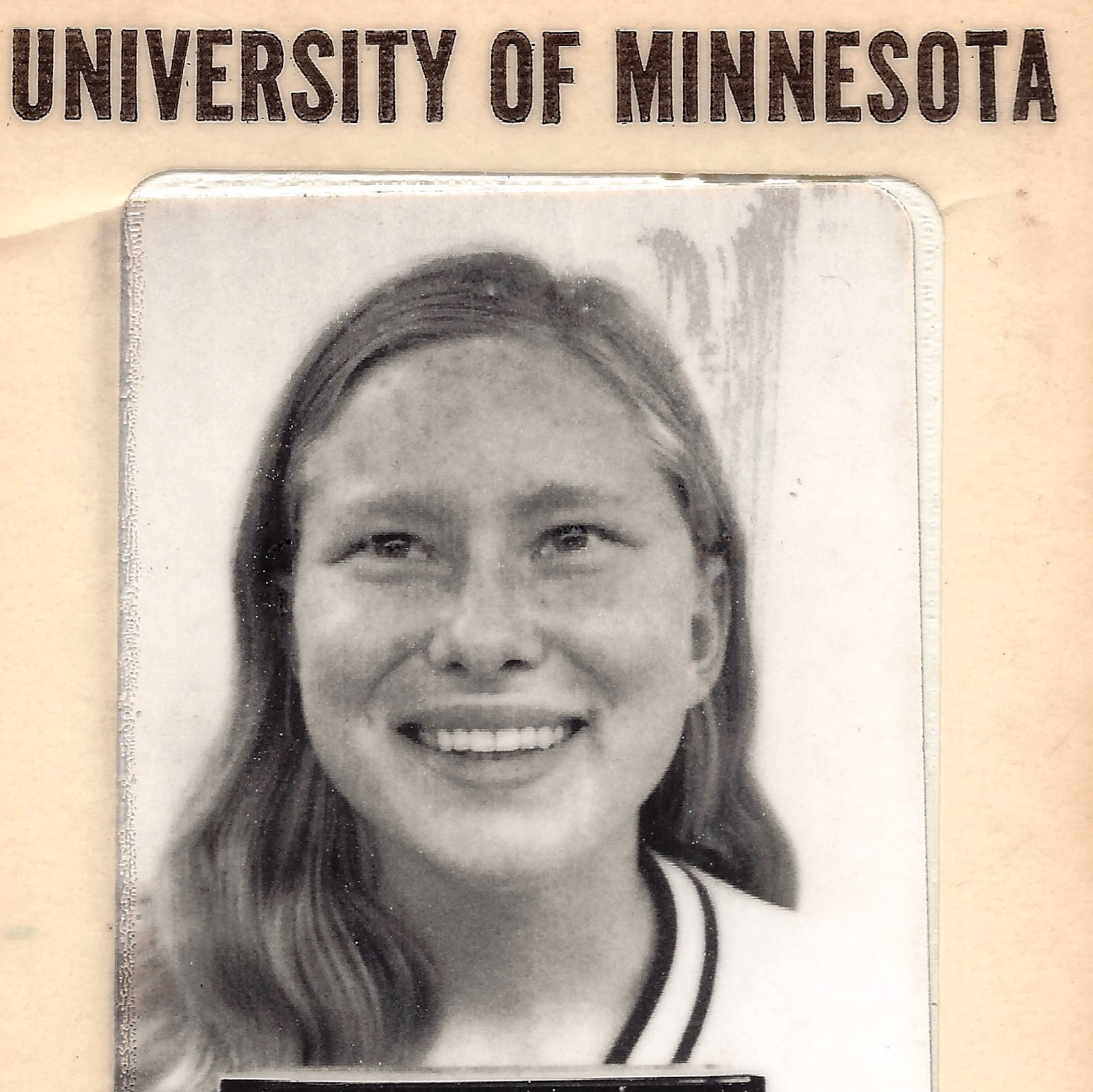 Me at 15 in my college ID for my summer classes. |
|||||
| 1968 | ||||||
| I joined the Girls Athletic Association, where, to earn a letter, we were required to attend boys' sports events as cheering spectators. Girls weren't allowed to play sports; only boys were. Upon discovering that there were no sports opportunities for girls outside of cheerleading, I began my first protest: walking alone in the rain from school to the District Supervisor's office to lodge a complaint. | 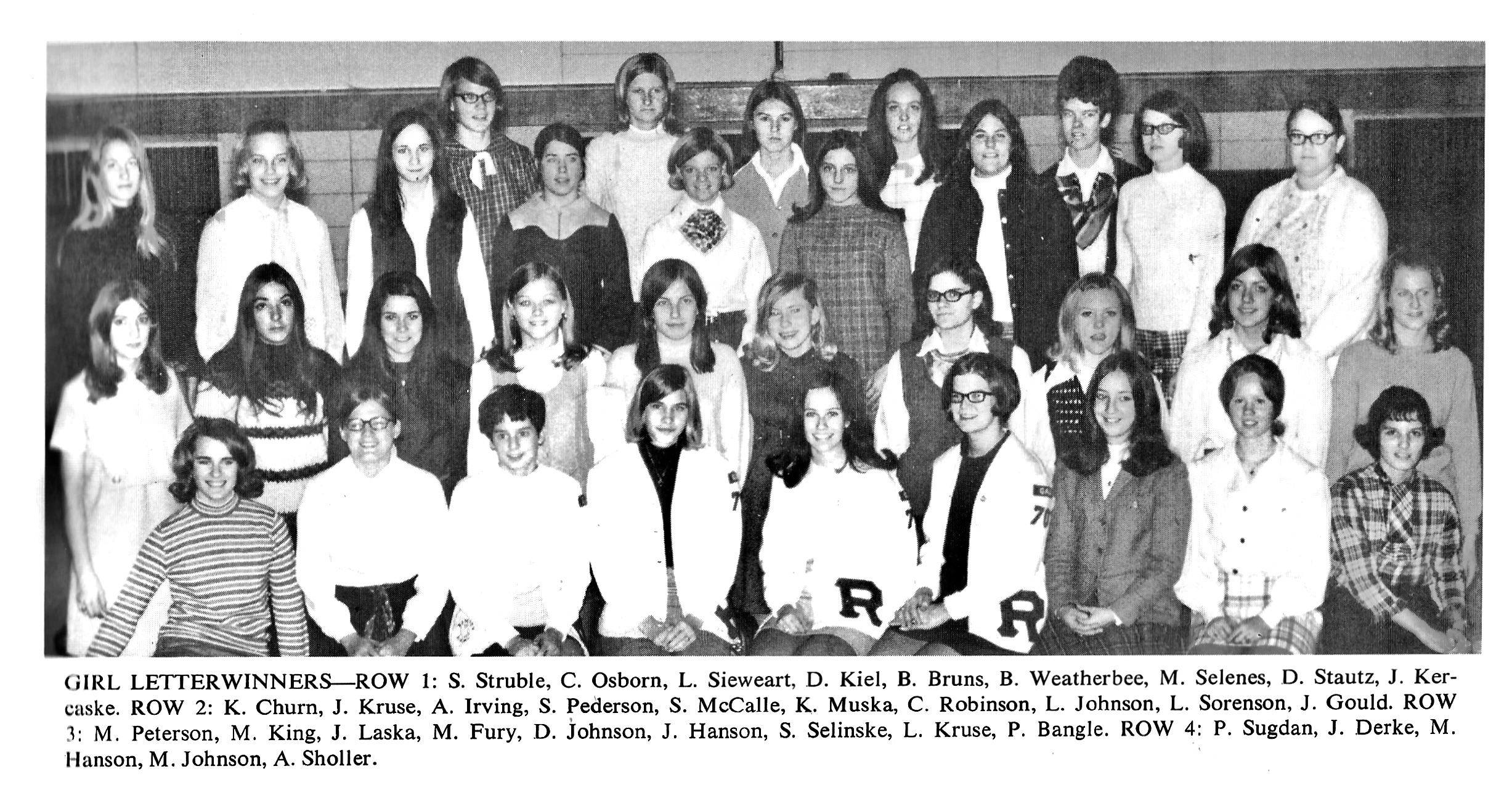 Girls Athletic Association, Ramsey High School, 1970 Rambler Yearbook, before Title IX.I'm in 2nd row, 5th from the right. Girls Athletic Association, Ramsey High School, 1970 Rambler Yearbook, before Title IX.I'm in 2nd row, 5th from the right.
|
|||||
| Camera Acting as My Voice | ||||||
| 1970 - 1972 | ||||||
At the age of 17, I enrolled at Minnesota State University Moorhead. I honed my photography skills by volunteering for the Moorhead student newspaper, “The Advocate,” and borrowed their Rolleiflex twin lens reflex camera. For me, photography was more than just a hobby; it was a need. Due to early childhood concussions, writing was a challenge for me. Photography became my way of communicating and connecting with people. I deeply respected it as a profession. Growing up, being treated as an "other" due to my gender instilled in me a fervent desire for fairness and justice. My camera became my voice, championing equality and understanding.
Two of my photographs published in the Moorhead student newspaper, "The Advocate." First: In 1972, former students, now returning soldiers, marched to the ROTC building to speak about their experiences Vietnam. Second: Moorheadstudents, friends, family, and the interested public gathered at a forum about Vietnam. |
||||||
| 1972 | ||||||
| I transferred to Ohio University in Athens, Ohio, to pursue a major in photography. | ||||||
| 1973 | ||||||
| In Athens, I began one of my major series titled “Nightlife, Athens, Ohio.”Moving from Minnesota, where the drinking age was 21, to Athens, where it was 18, came as a shock to me. To face my apprehensions head-on, I immersed myself in the downtown scene. I would walk the two blocks of Court Street with my camera and flash securely fastened to my hip. Using my hand, I'd remotely aim at passersby, capturing their spontaneous reactions. | 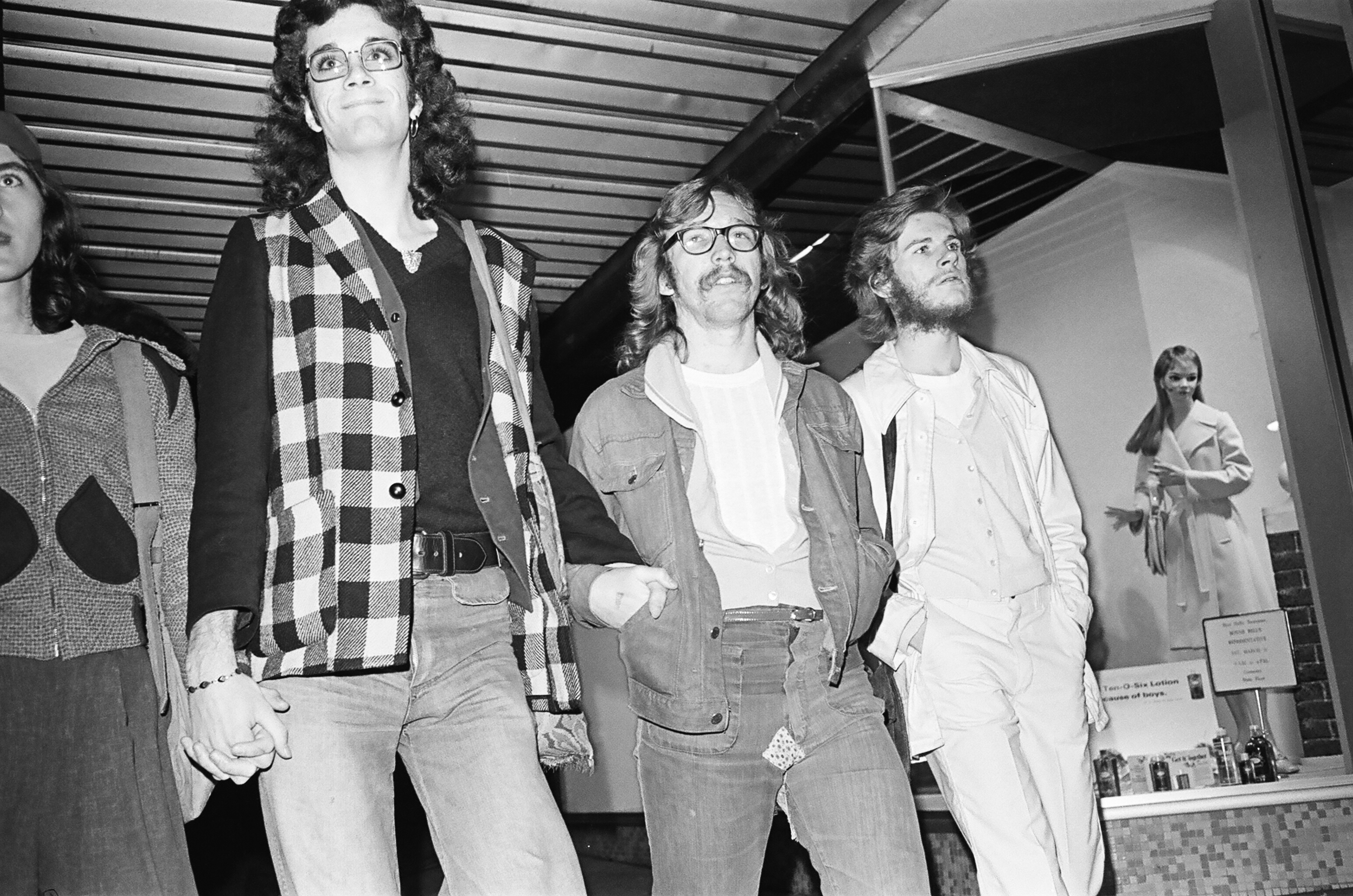 In 1973-74, on Friday and Saturday nights, I photographed “Nightlife," people on two blocks of Court Street in Athens. Click on photo to link to short "Nightlife" video. |
|||||
| Coming Out, A New Life as MeadowLark | ||||||
| 1973 | ||||||
| At the age of 20, I came out as a lesbian after meeting a woman from South Chicago while searching for the original Amazon bookstore in a condemned house in South Minneapolis. | 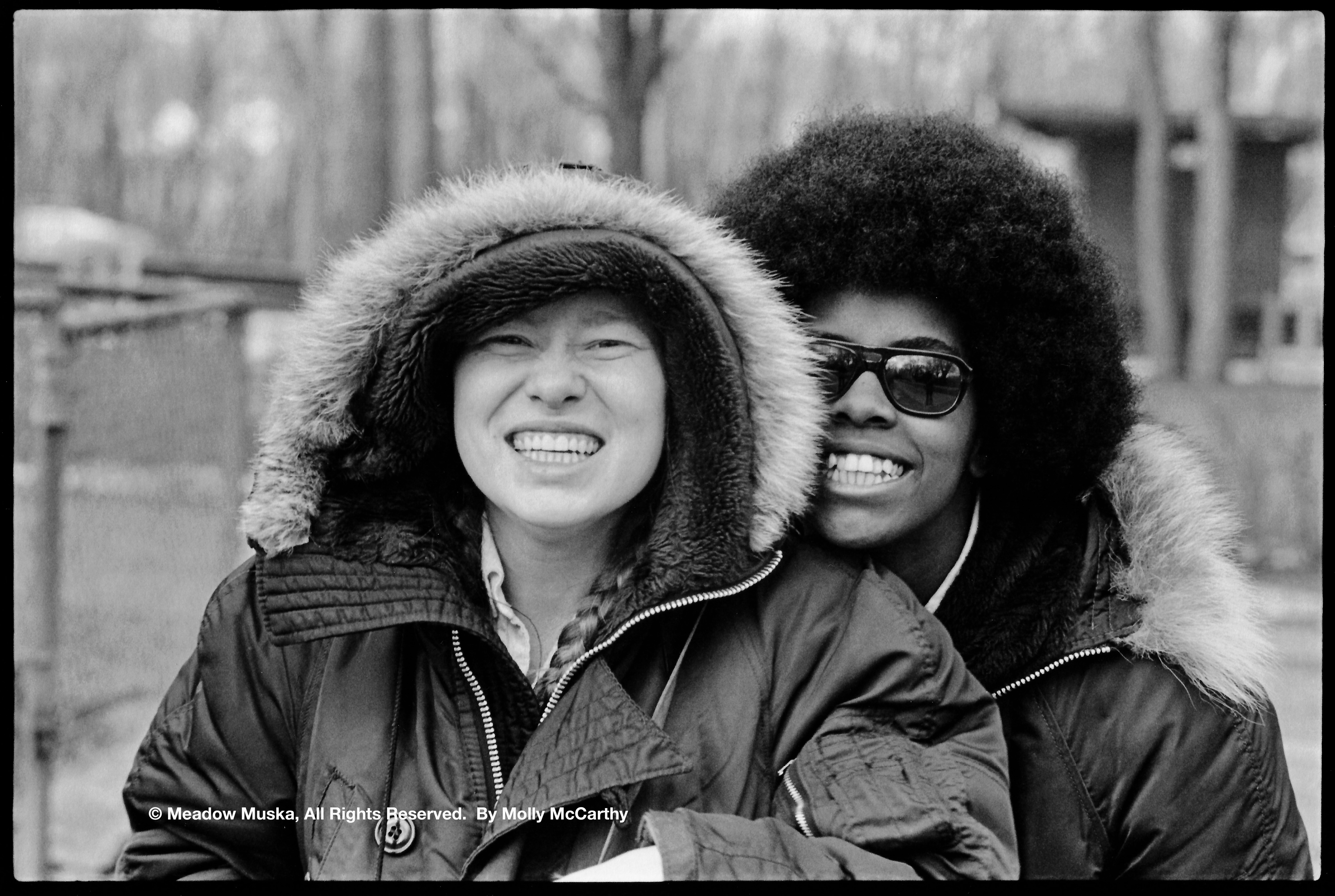 I “played camera” with my friend Molly McCarthy, who shot this image of me (at left) and my partner at the Como Park Zoo in Minnesota.Click on image to link to photos of Minnesota women. |
|||||
| 1974 | ||||||
| I graduated summa cum laude from Ohio University with a BFA in photography.
I joined a van carrying six other women, embarking on a journey to a Women's Solstice Celebration in the Jemez Mountains of New Mexico. Afterward, I hitchhiked and spent several months living on the streets of San Francisco. Later, I returned to Minnesota and transformed an old mail truck into a mobile living space. I equipped it with paneling, carpet, cupboards, a cooler, and a platform with vinyl-covered foam that served as a bed. |
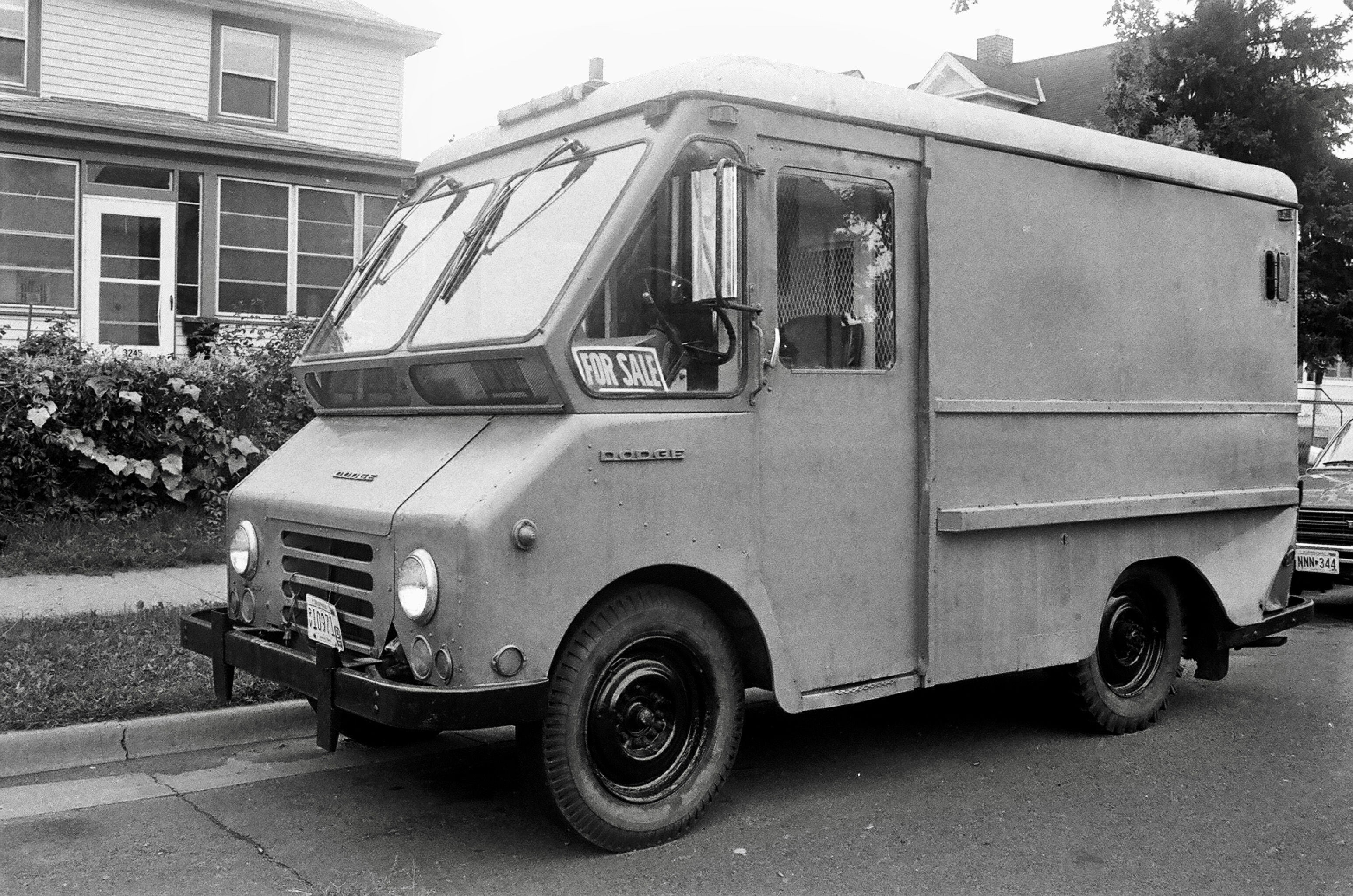 The one-ton mail truck I converted into a mobile living home and lived in from 1975 to ’76. The one-ton mail truck I converted into a mobile living home and lived in from 1975 to ’76. |
|||||
| 1975 - 1976 | ||||||
| Driving the van, I returned to the Summer Solstice in New Mexico, then continued on to the WomanSpirit Celebration in the mountains of Southeastern Oregon. Afterward, I joined the vibrant lesbian community in Eugene. Adopting the name MeadowLark, I began a new chapter of my life. I used my camera to capture lesbians as I perceived them: as beautiful, strong women radiating love and joy. | 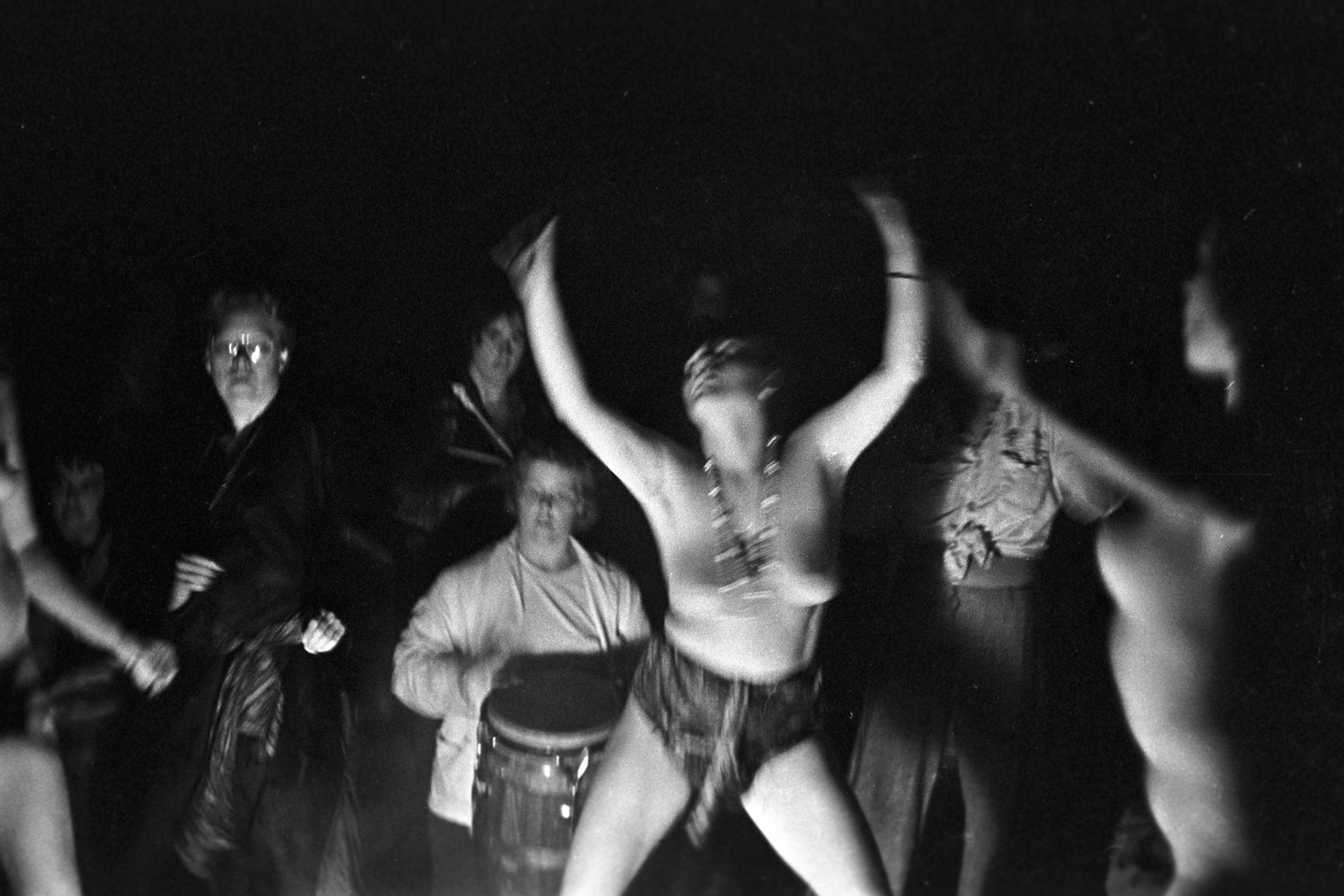 Dancing around the campfire at the WomanSpirit Celebration in the mountains of Southeastern Oregon in 1975. Click image for link to video. Dancing around the campfire at the WomanSpirit Celebration in the mountains of Southeastern Oregon in 1975. Click image for link to video. |
|||||
| 1975 - 1976 | ||||||
I lived in my truck in the Women’s Community in Eugene. I documented the community's concealed life, as they trusted me to shield them from public scrutiny, violence, and discrimination. During an era when using a professional camera's mechanical adjustments and the skills to develop and print photographs were uncommon for women, I offered photography classes in the upstairs bathroom of Gertrude's Silver Note Café.
|
||||||
| 1976 | ||||||
| Working as a staff photojournalist for a small newspaper in Oregon, I was assigned to photograph two dogs. They turned out to be working dogs at an FBI convention, and my career as a photojournalist was over. | 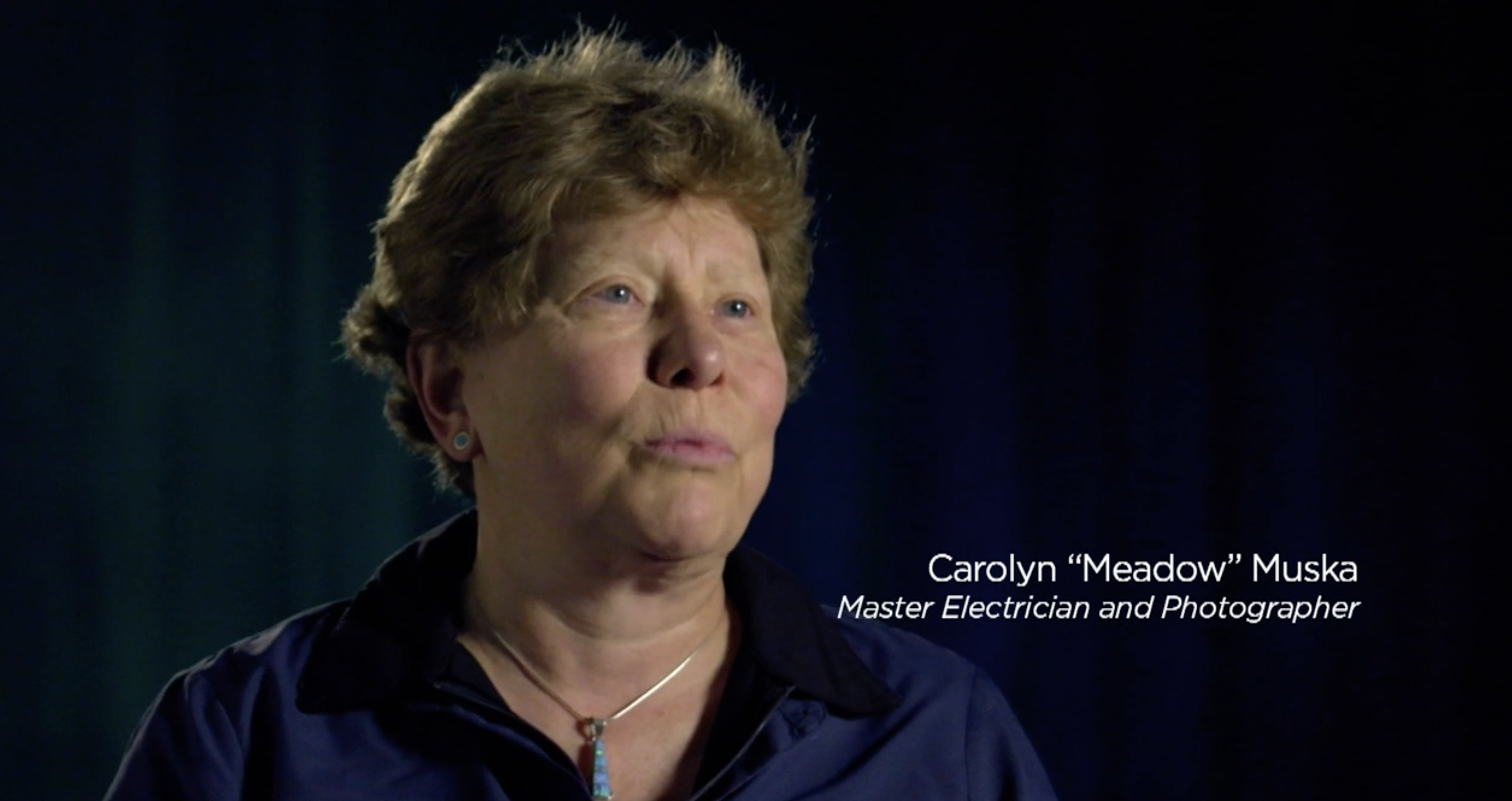 In the 2017 Twin Cities PBS series="Our Rights 101,"I share my experience of theloss of my photojournalist career.Click photo for link to PBS interview. |
|||||
| Trade School, Minnesota Land Dykes | ||||||
| September 1976 - May 1978 | ||||||
| I returned to Minnesota to enroll in the Dunwoody College of Technology in Minneapolis, becoming the first woman to graduate in the Electrical Construction program. In my free time, I traveled to Minnesota Women's Land. | 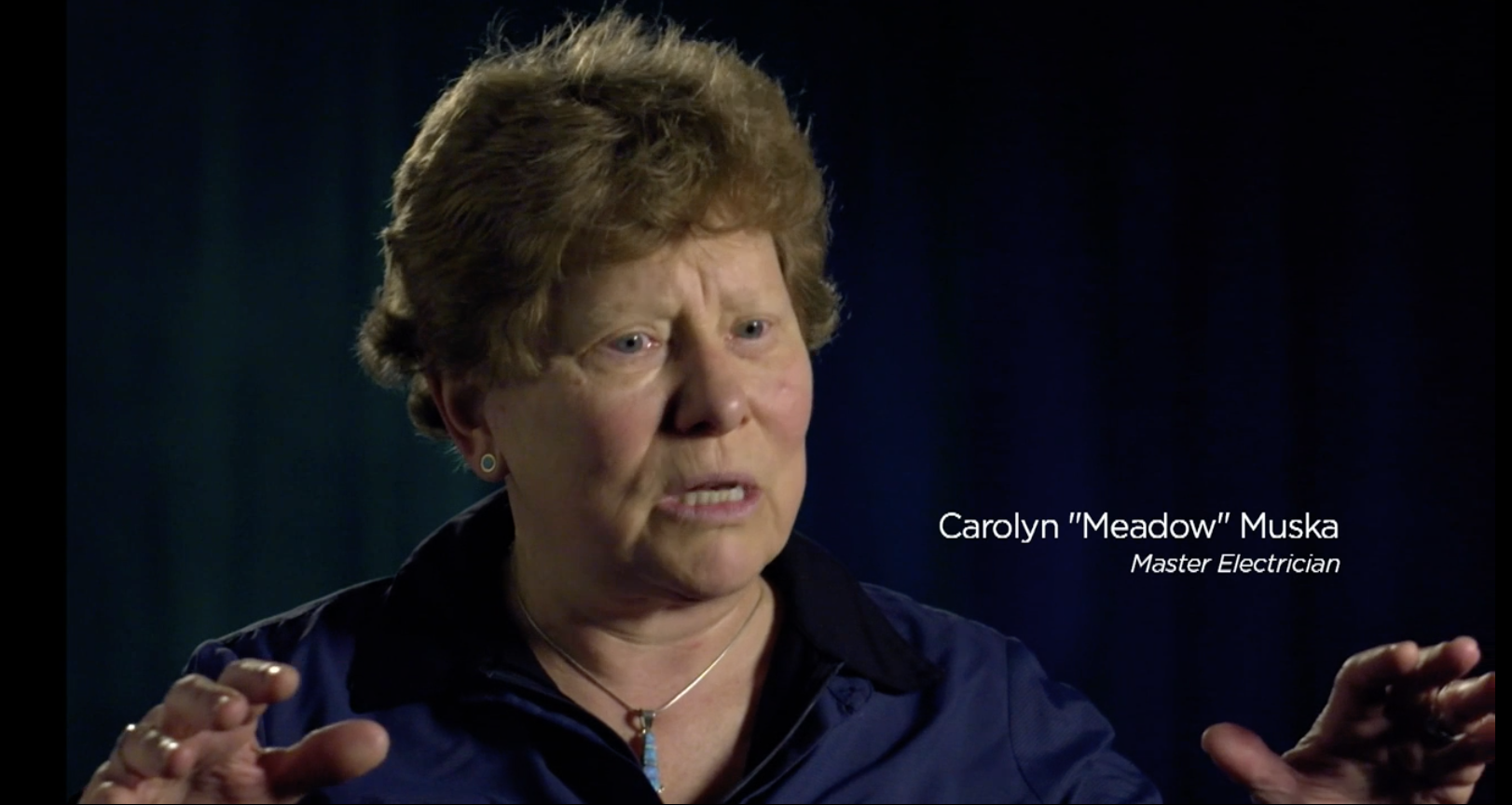 In the Twin Cities PBS series "Our Rights 102," I discuss the harassment and discrimination I experienced at Dunwoody and in my work as a union electrician.Click here for link to interview video. In the Twin Cities PBS series "Our Rights 102," I discuss the harassment and discrimination I experienced at Dunwoody and in my work as a union electrician.Click here for link to interview video. |
|||||
| Weekends, I visited Women’s Lands in Minnesota, bringing my camera and groceries. I shot many photographs at Rising Moon, one of the early Women’s Lands, located in rural Aitkin. | 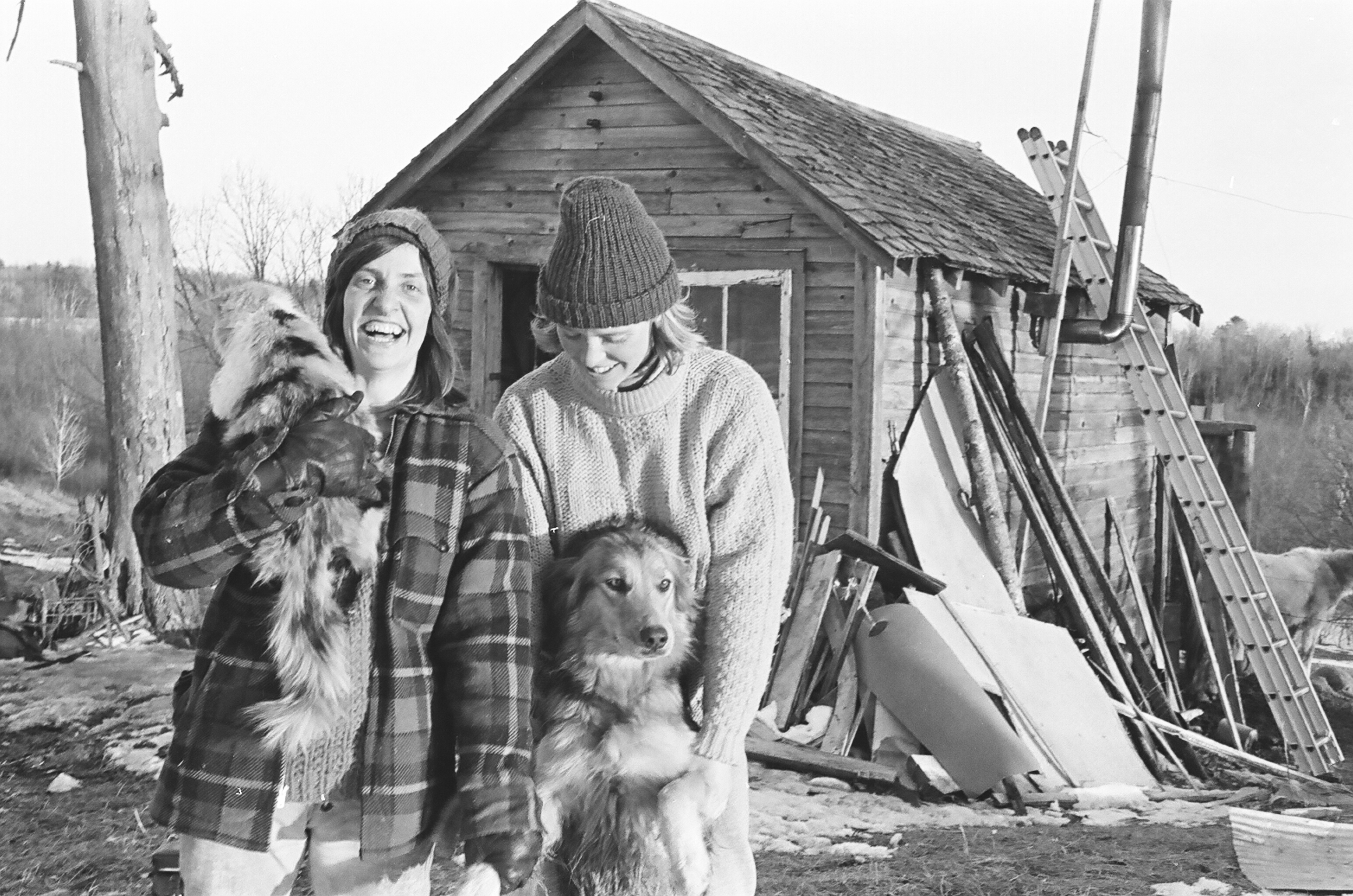 At Rising Moon in Aitkin, Lisyli Hardin and Robin Deeming remodeled a shack into a home. They warmly welcomed me to Women's Land.Click on photo to link to Minnesota photos.
|
|||||
| I chronicled the Minnesota Landykes movement, which originated in Aitkin with Rising Moon as the original location. Mel's Place and Del Lago followed. | 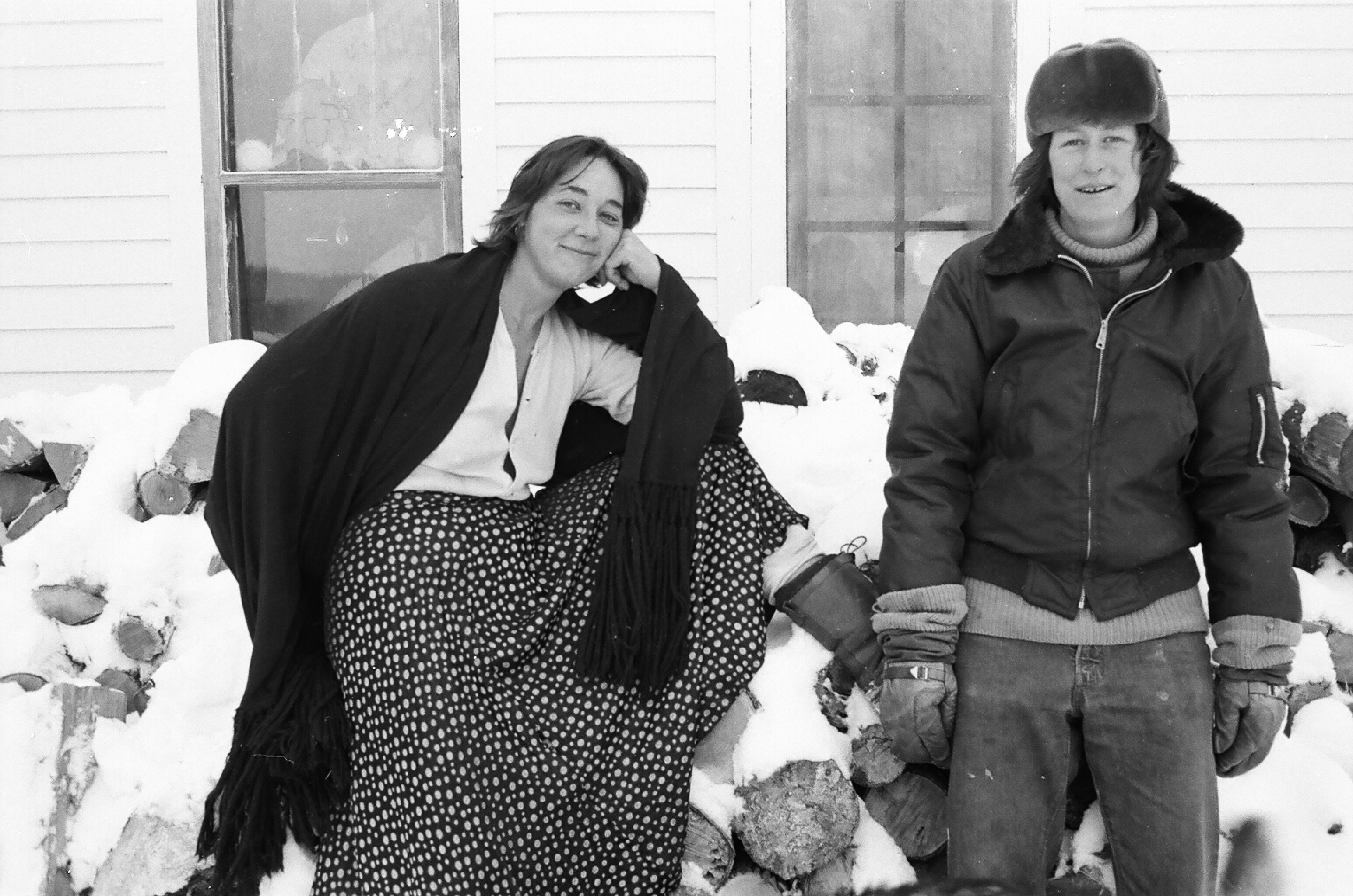 In Del Lago, 1977, Aitkin Landykes members Blue Demaesschalck and Molly McCarthy posed near the wood stack. Click on photo to link to Minnesota videos. In Del Lago, 1977, Aitkin Landykes members Blue Demaesschalck and Molly McCarthy posed near the wood stack. Click on photo to link to Minnesota videos. |
|||||
| June 1978 | ||||||
| Despite facing challenges in an era when harassment was not only tolerated but common, I graduated second in my class. |
|
|||||
| June 1978 - 1982 | ||||||
| Hired by IBM for customer engineering, winning award for developing efficient trouble report system for repairing computers.
I quit IBM to become a union electrician, expecting some free time during the winters to do photography and work for social justice. I also wrongly believed that time would have improved the culture of misogyny, racism, and homophobia. |
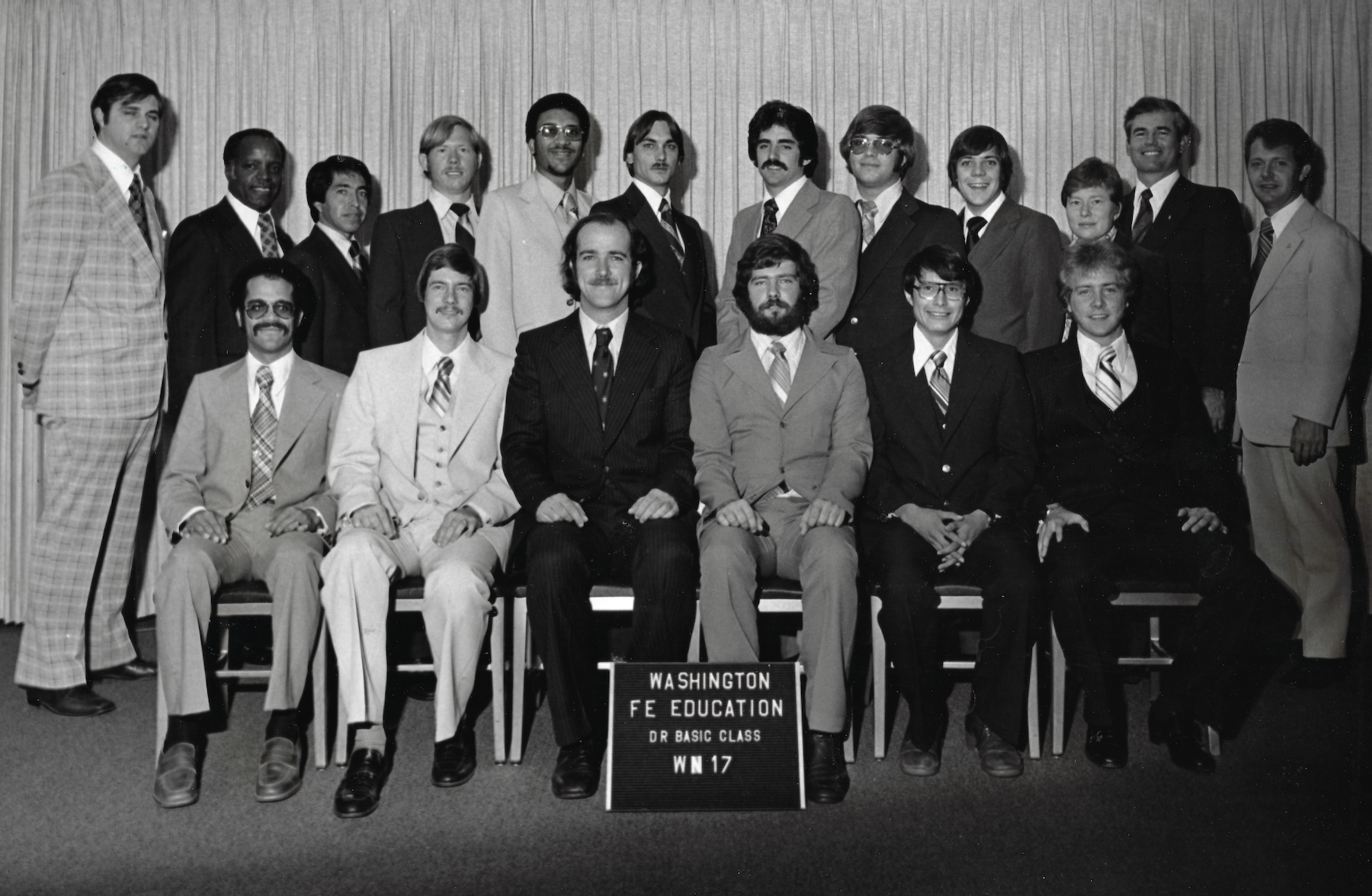 In 1978, I graduated as an IBM CE (Customer Engineer) in Washington, D.C. I can be spotted in the back row, third head from the right. |
|||||
| Women in the Trades | ||||||
| 1983 - 2006 | ||||||
| As only the fourth woman to join the St. Paul Electrical Workers' Union, I climbed the ranks, moving from apprentice to journey level and finally to Master Electrician. I faced daily challenges, including exposure to pornography, discrimination in job assignments and training, isolation, and harassment. | 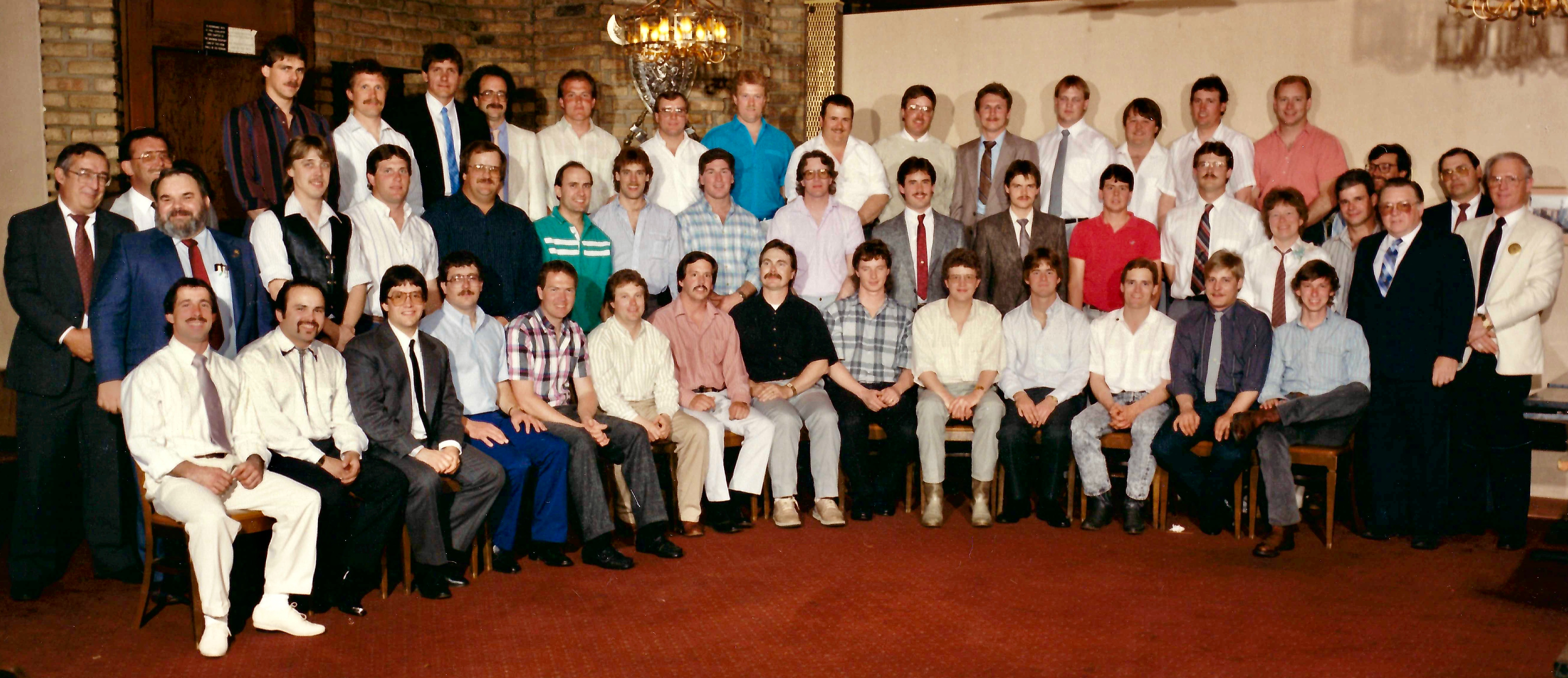 In the 1989 St. Paul Electrical Workers' apprenticeship graduation class, I can be identified as the woman wearing a white shirt and tie, located in the second row on the right. In the 1989 St. Paul Electrical Workers' apprenticeship graduation class, I can be identified as the woman wearing a white shirt and tie, located in the second row on the right. |
|||||
| 1989 | ||||||
| In response to blatant sexism, racism, and homophobia, I founded and coordinated "Minnesota Women in the Trades," a nonprofit advocacy group. | 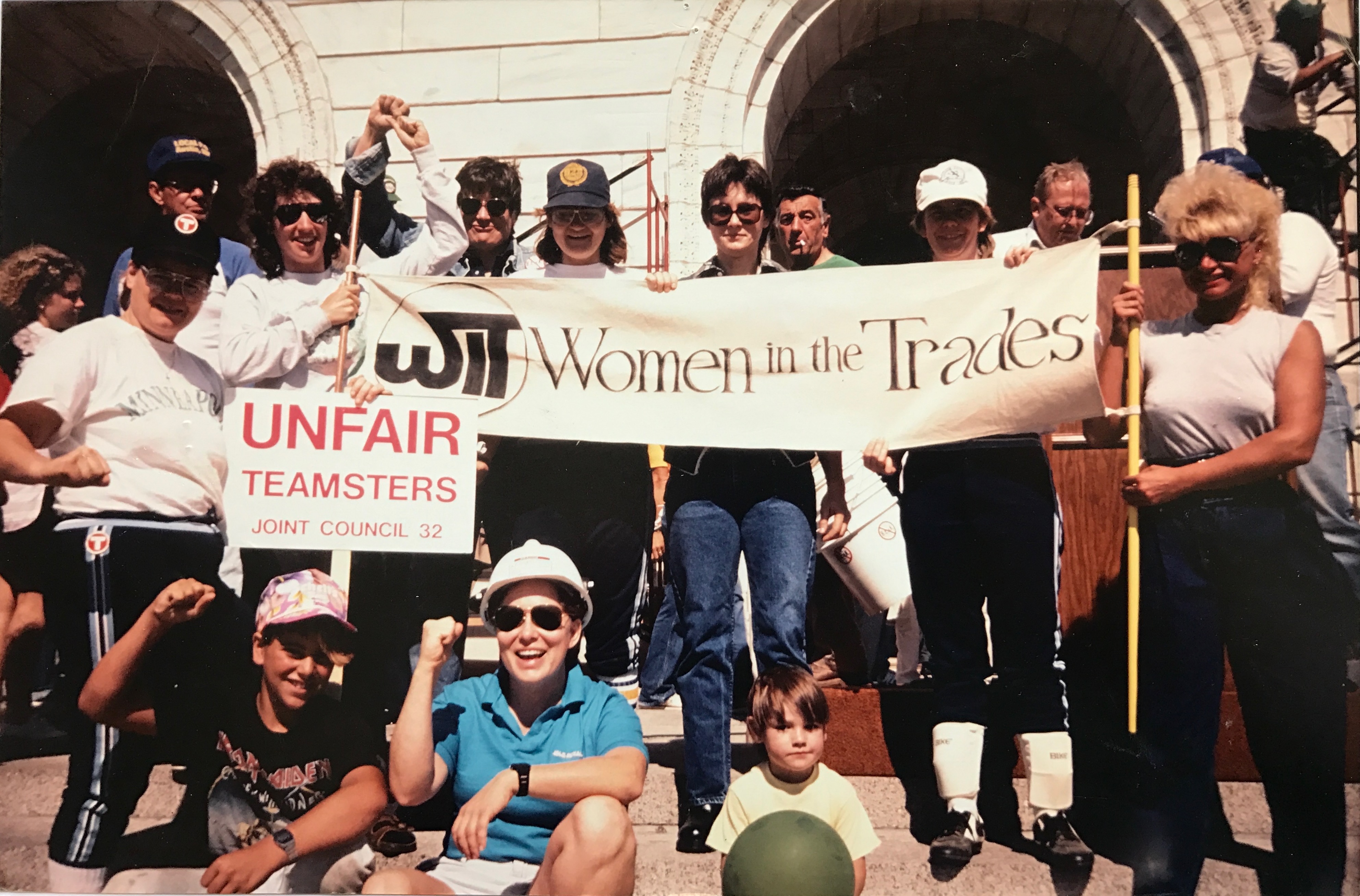 In September 1990, I led "Women in the Trades"to the top of the steps at the State Capitol. I can be spotted at the front, wearing a blue shirt and a white hard hat. |
|||||
| 1989 - 1992 | ||||||
| Published Words of WIT newsletter, advocating for the value of diversity in the trades. | 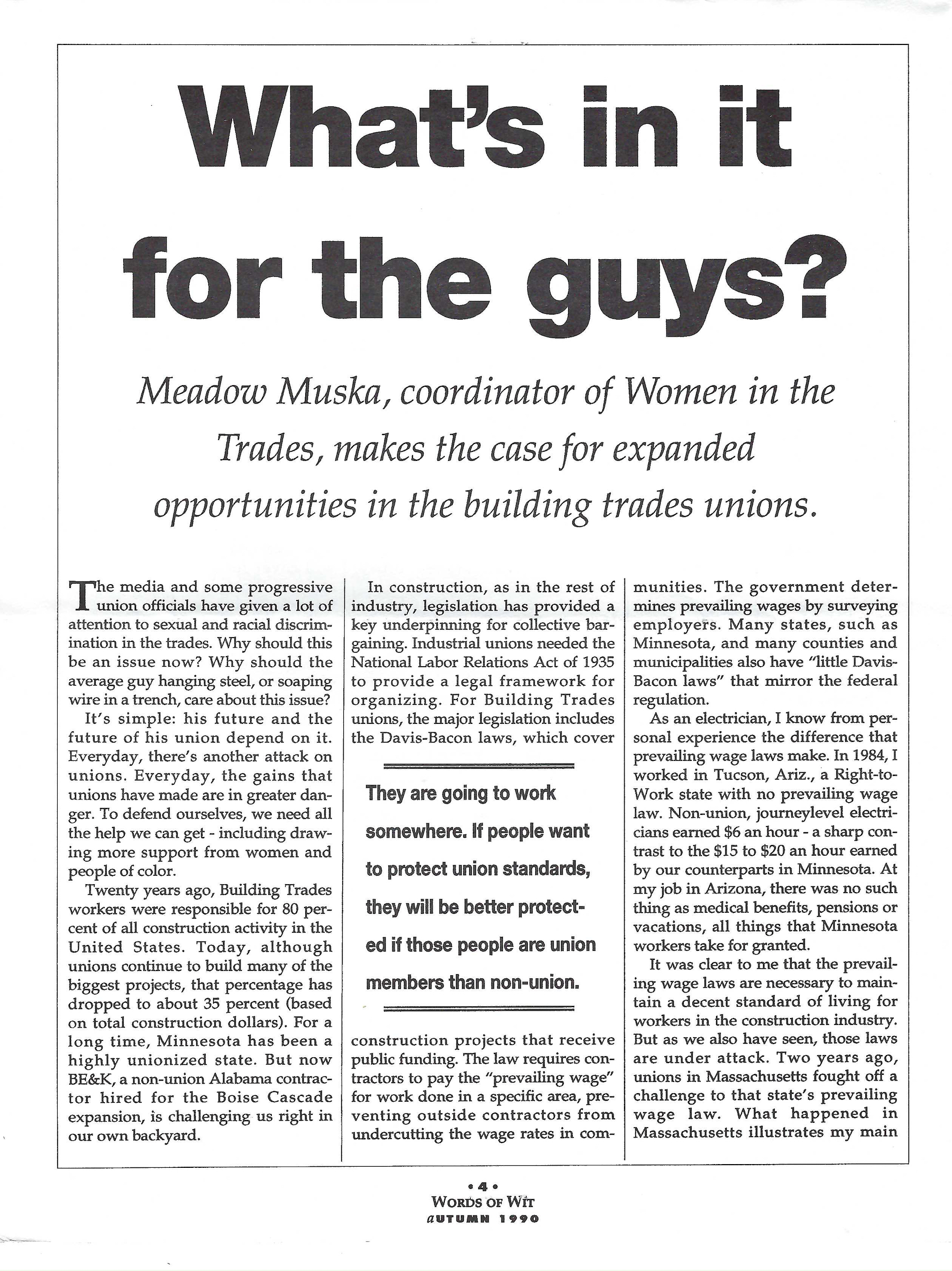
My 1990 article makes the case for expanding opportunity in the building trade unions Click for pdf. |
|||||
| December 1990 | ||||||
| As coordinator of Minnesota Women in the Trades, I brought public attention to harassment in the building trades. My efforts significantly contributed to increasing the representation of women and people of color in construction. | 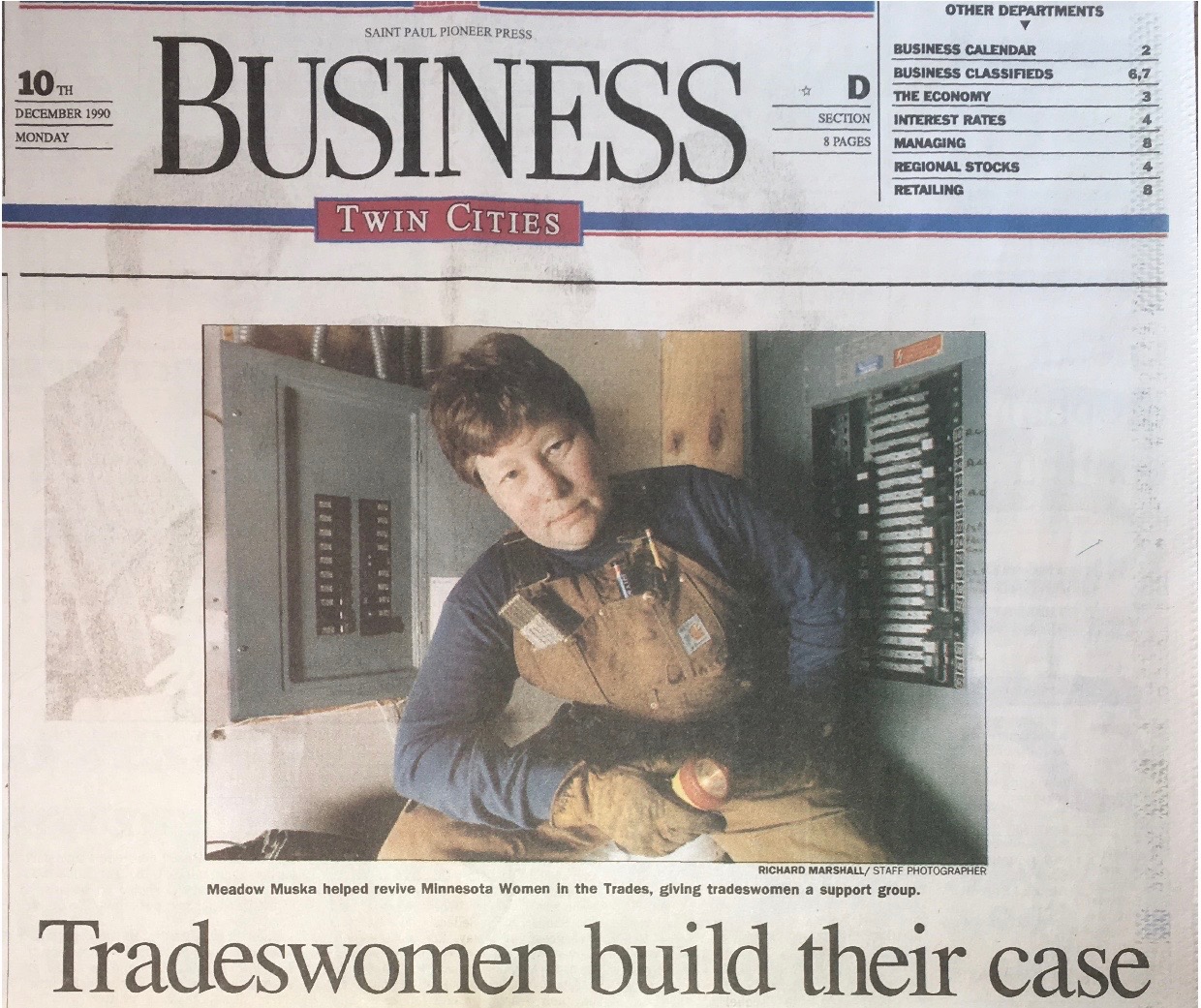 St. Paul Pioneer Press, December 10, 1990 |
|||||
| 1991 | ||||||
| Guest Speaker at the Minnesota AFL-CIO Convention in Rochester as Ray Waldron, a supporter and friend, and the president of the building trades, looks on. | 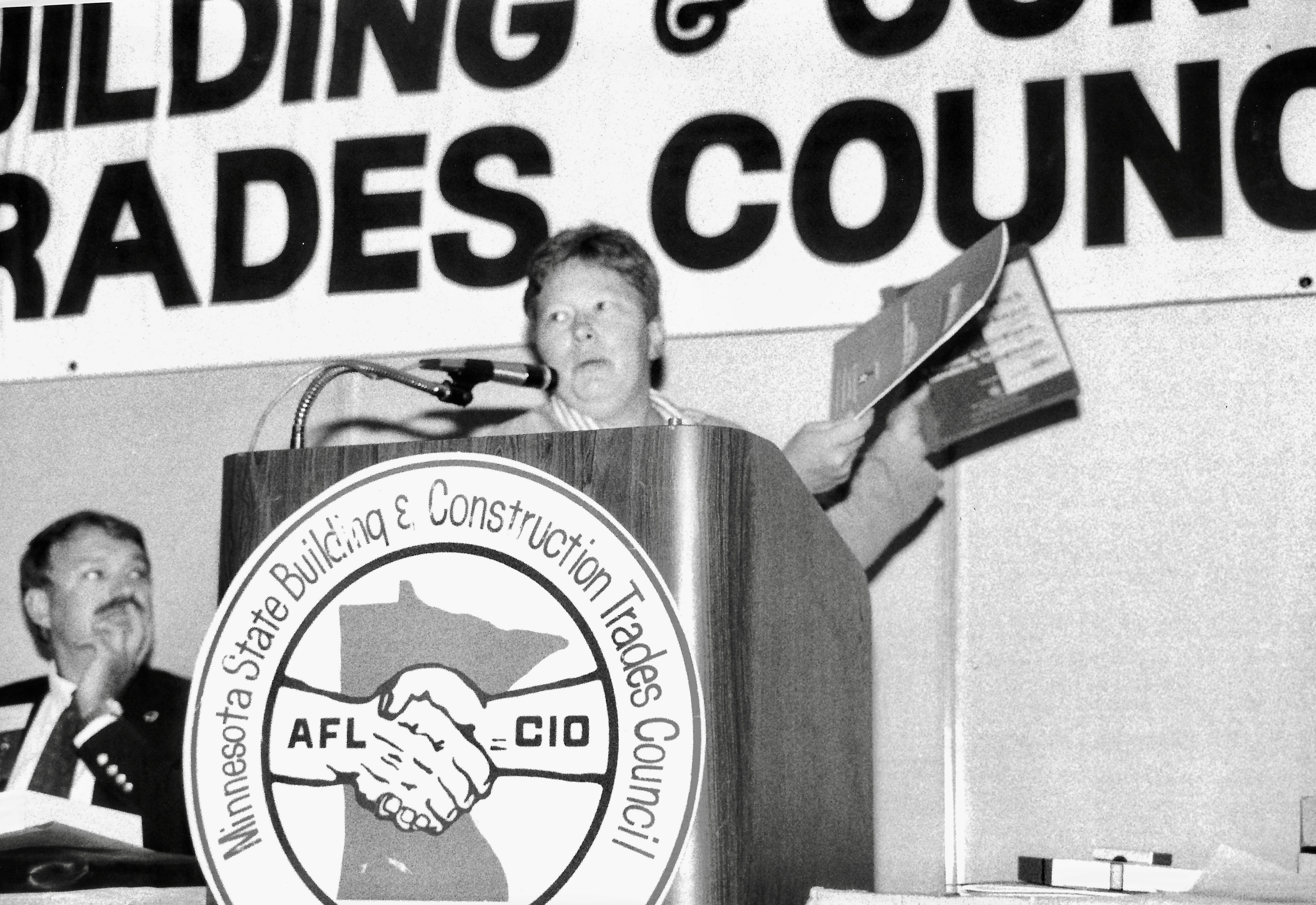 Guest speaker at Minnesota AFL-CIO Convention in Rochester. Diversity, "What's in it for the Guys?" 1991 Guest speaker at Minnesota AFL-CIO Convention in Rochester. Diversity, "What's in it for the Guys?" 1991 |
|||||
Basic information on who, what, where, how, and when to get into the building trades in Minnesota was unavailable to the general public, keeping women and people of color from getting good paying jobs. I wrote a grant and supervised an intern to collect this basic critical information and had it published in 1991. This information should have been available through the Minnesota Department of Labor. |
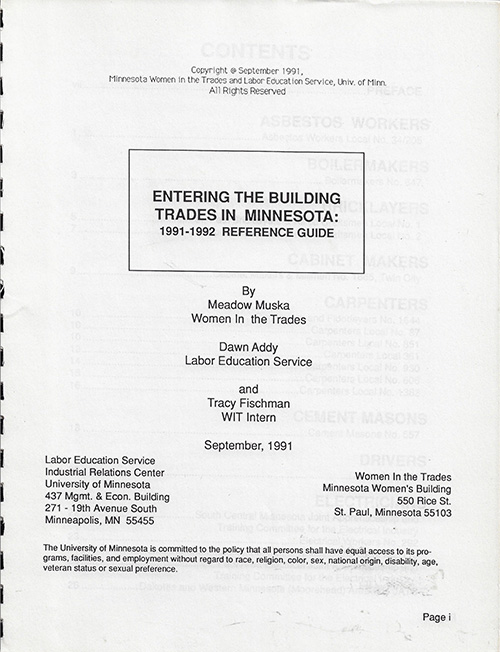 Click for PDF |
|||||
| Master on Record; Women Build | ||||||
| 1983 - 2006 | ||||||
| I branched out into maintenance, with a specialization in instrumentation and troubleshooting. As a Master in my field, I served as the Lead Electrician and was the Master on record for three wastewater treatment plants. In 1999, I accepted a buyout from the Metro Waste Control Commission and subsequently began working for the St. Paul Public Schools. | 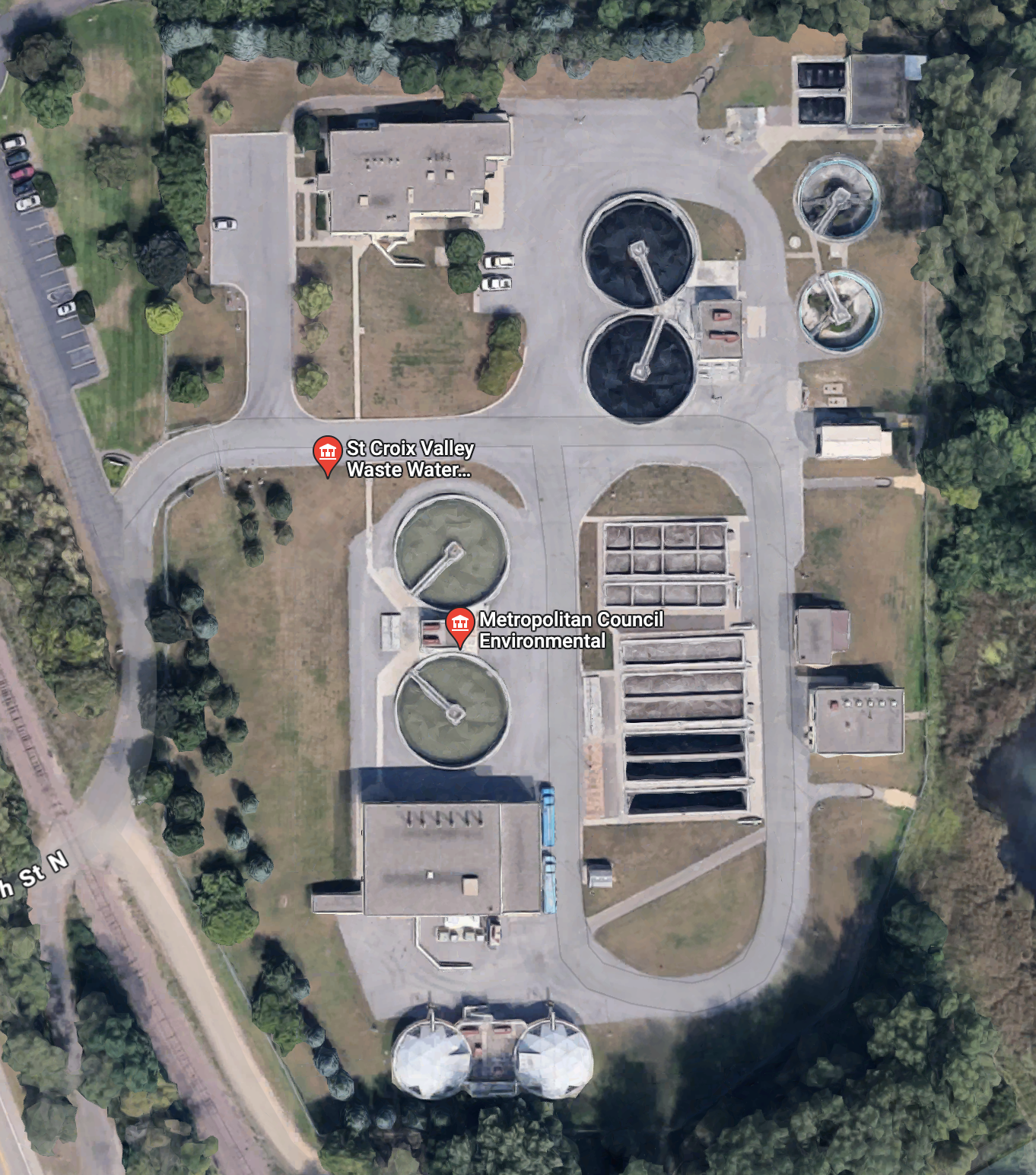 Cottage Grove WasteWater Treatment Plant, one of the three plants I serviced. |
|||||
| 1993 | ||||||
| After hearing remarks that "girls couldn't build a house," I worked with Habitat for Humanity to create a training program called Women Build. | ||||||
| 1993 - 1996 | ||||||
| As a leader and advocate for women in the building trades, I was appointed by Governor Arne Carlson to the Minnesota Department of Labor and Industry Board. | ||||||
| 1993 | ||||||
| I leave my volunteer position as the Women in the Trades Coordinator, after sustaining a concussion from an auto accident. | ||||||
| 2006 | ||||||
| I retire from my career as Master Electrician. | ||||||
| Photography Returns | ||||||
| 2006 - Present | ||||||
| I turned my attention back to the extensive photographic archive that I had kept hidden for over 45 years to protect the identities of the women. In 2018, I donated my negatives, slides, film, and papers have been donated to the Sophia Smith Collection of Women's History at Smith College. | Page from my archive of scanned and labeled images. Click on image to link to my papers at Sophia Smith Collection of Women's History. |
|||||
| 2016 | ||||||
| As part of the nonprofit Old Lesbian Oral History Program, I volunteered both to interview others and to be interviewed myself. | 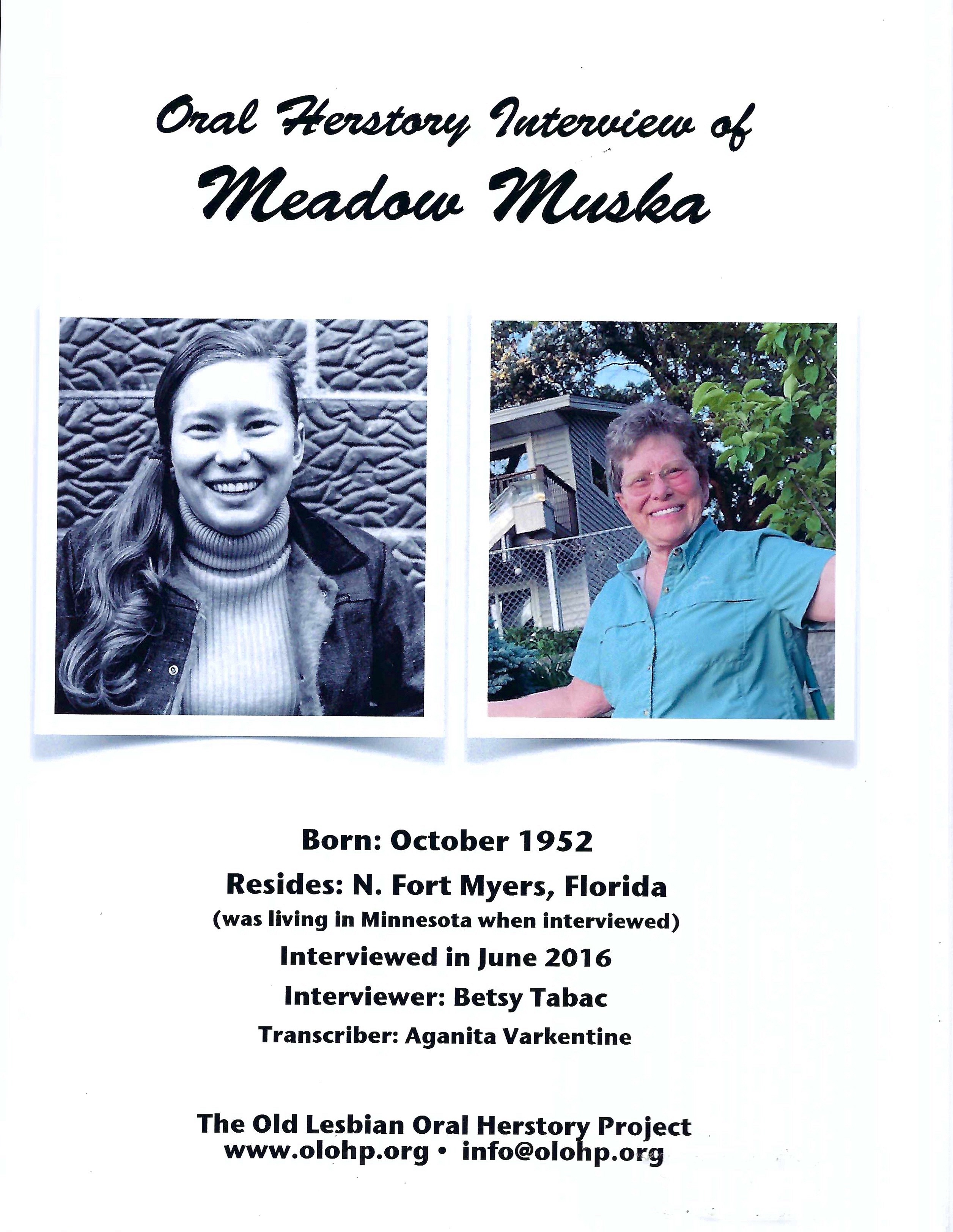 Cover of volumn one of my interview. |
|||||
| 2017 | ||||||
| The Jean-Nickolaus Tretter Collection in Gay, Lesbian, Bisexual, and Transgender Studies invited me to participate in a panel discussion about creating lesbian spaces. In response, I produced a 16-minute video detailing my lesbian history. The video,“Photography as a Revolutionary Act,” is posted on the website of TPT, the Twin Cities local PBS station. | 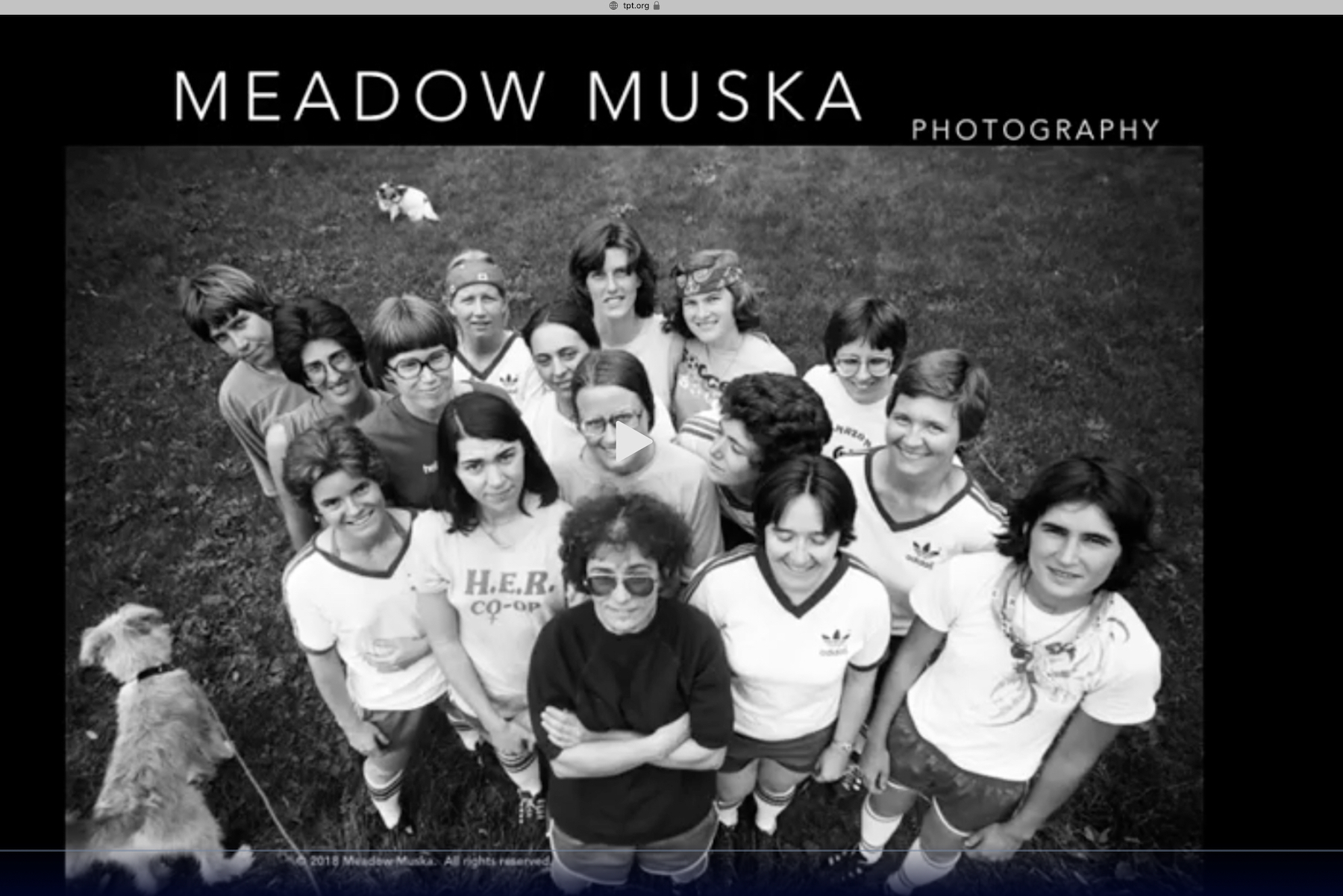 Click "Photography as a Revolutionary Act" for video. |
|||||
| Photographs Go Public | ||||||
| 2017 | ||||||
| I revealed a section of my archive to the public for the first time in the TPT documentary "Out North: MNLGBTQ History," the first full-length film to document and celebrate Minnesota’s LGBTQ history. | 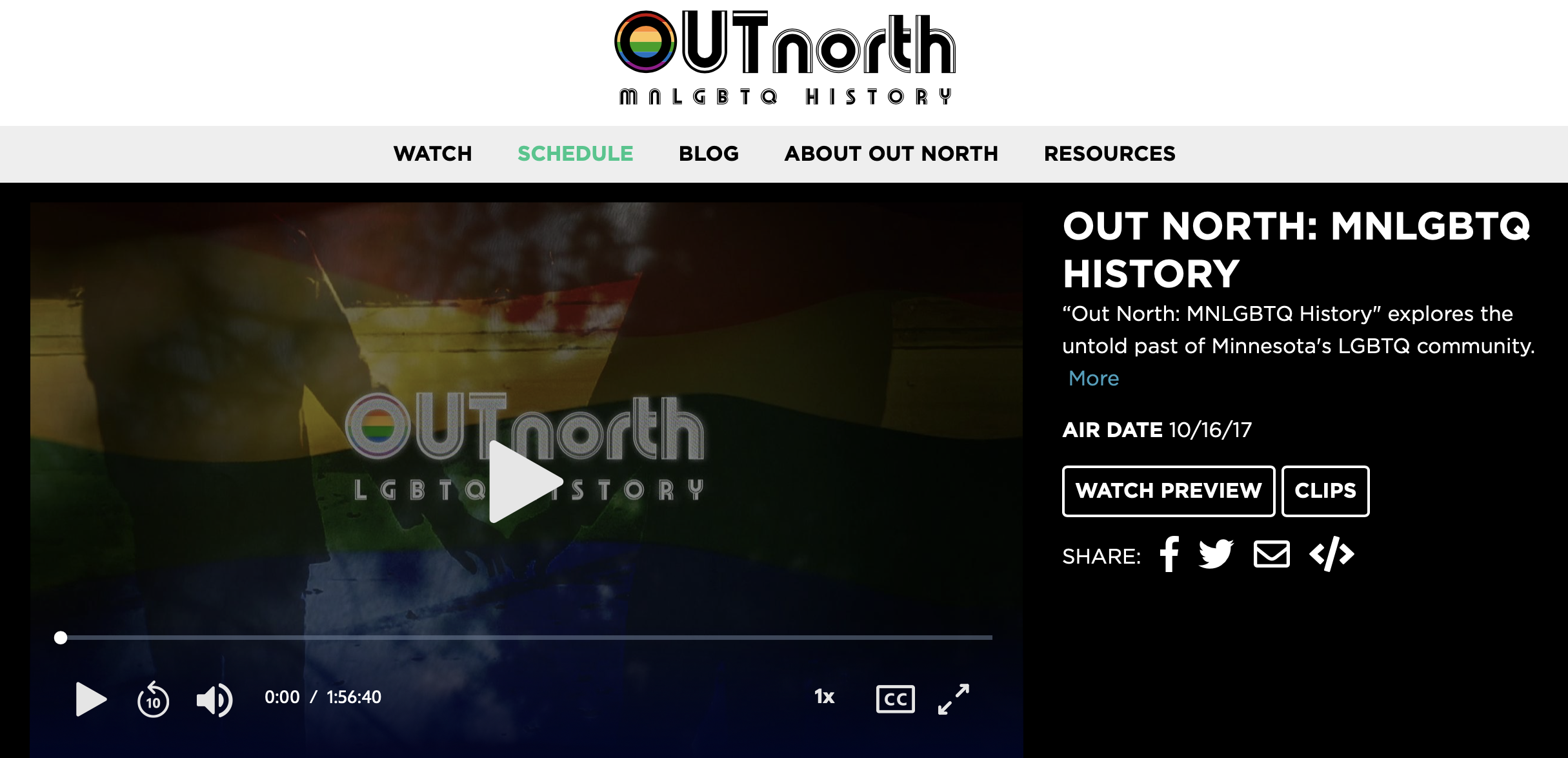 Click for link to Out North: MNLGBTQ History. Click for link to Out North: MNLGBTQ History. |
|||||
| 2018 | ||||||
| The Minneapolis Institute of Art hosted my first solo exhibition, "Strong Women, Full of Love", featuring 30 photographs from my archive. The Star Tribune recognized the show as one of the year's top ten exhibitions. | 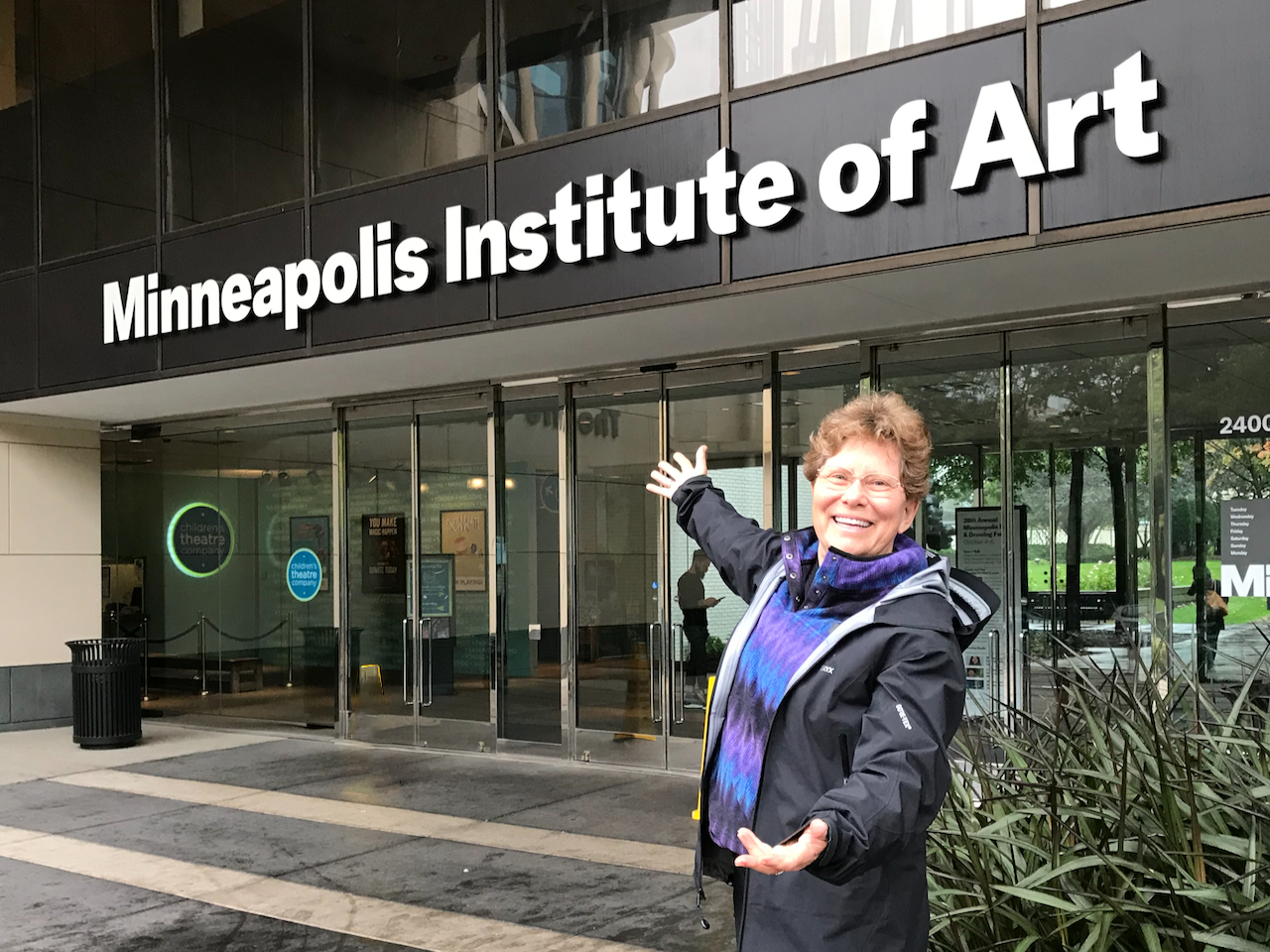 I celebrated my solo award wining show in the Minneapolis Institute of Art. Click on image for MIA Interview. |
|||||
| 2023 | ||||||
| I was interviewed for the Minnesota Lesbian Community Organizing Oral History Project by Lisa Vicoli, the initiative's founder. The interview will be archived at the Jean-Nickolaus Tretter Collection in GLBT Studies at the University of Minnesota Libraries. | 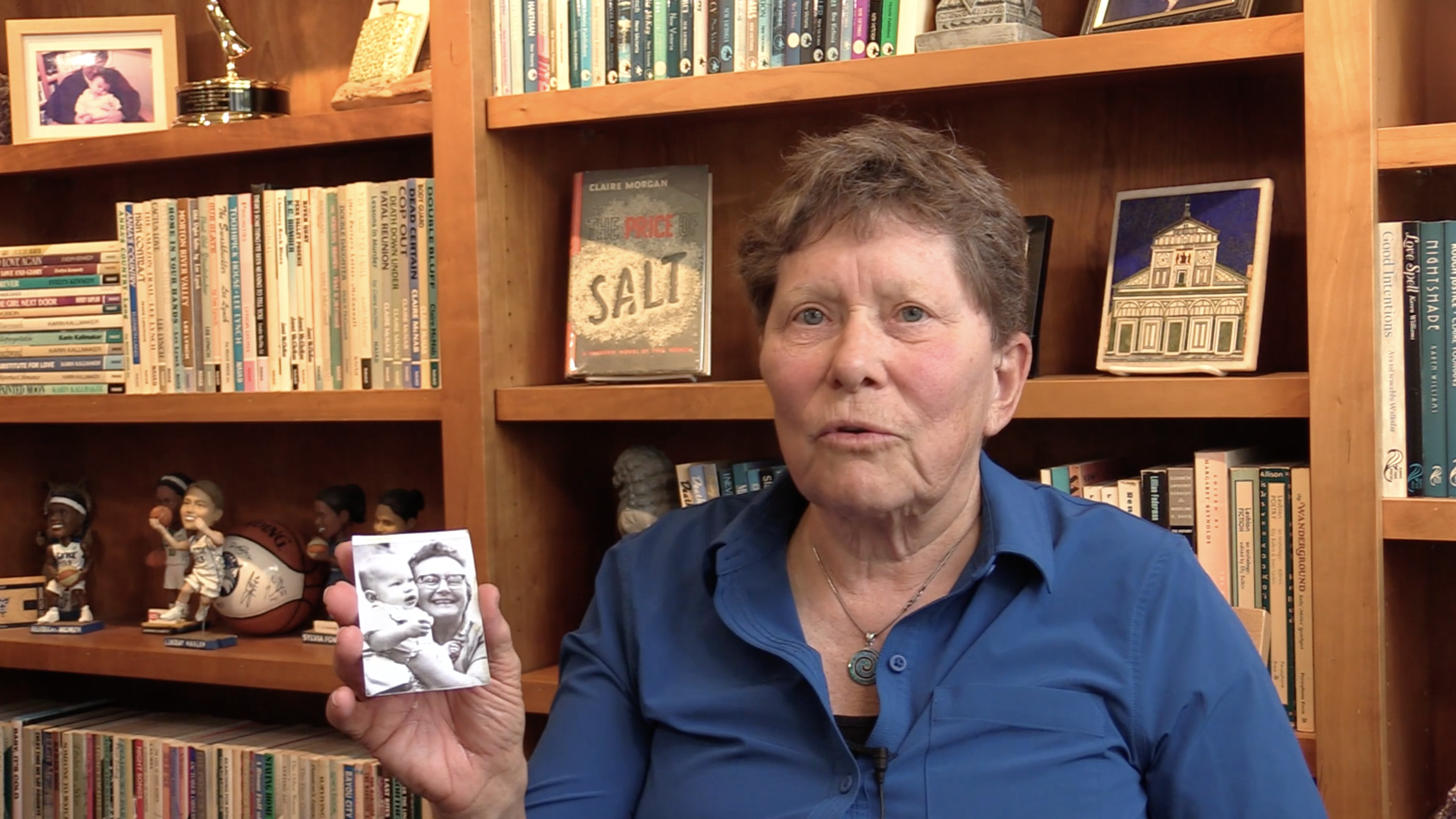 My interview about lesbian culture in the 1970 and 80s will be released soon. |
|||||
| Present | ||||||
| I'm working to bring my archive and the history it chronicles to wider attention.
My photos offer a rare record of a hidden lesbian world—dances, families, potlucks, festivals, soccer games, martial arts, our protests and struggles for equal treatment and social justice. I look forward to showing my photographs in more exhibitions, and to bringing my archive to the attention of scholars, historians, curators, journalists, filmmakers, and others. |
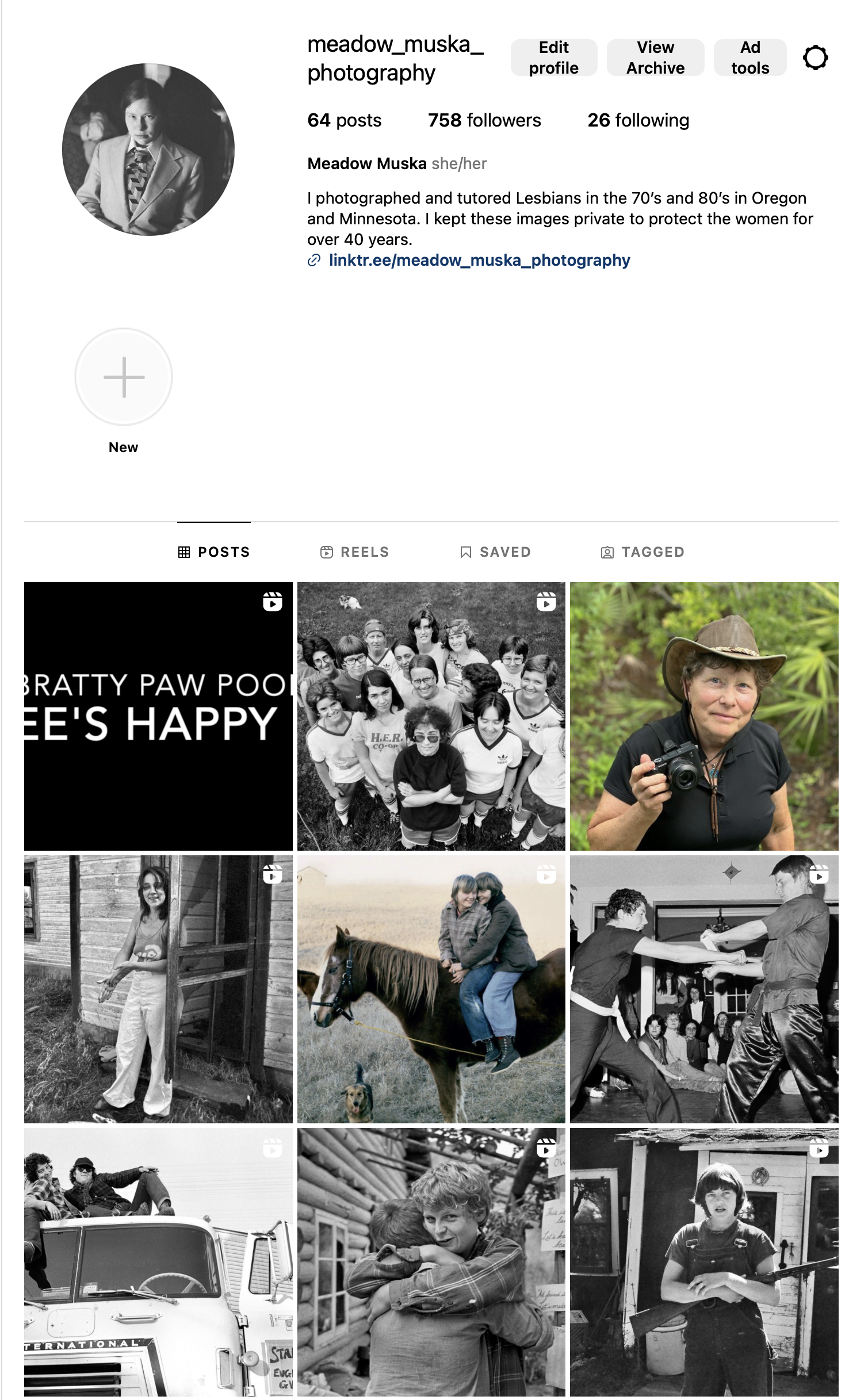 Click on image to see my Instagram account. |
|||||